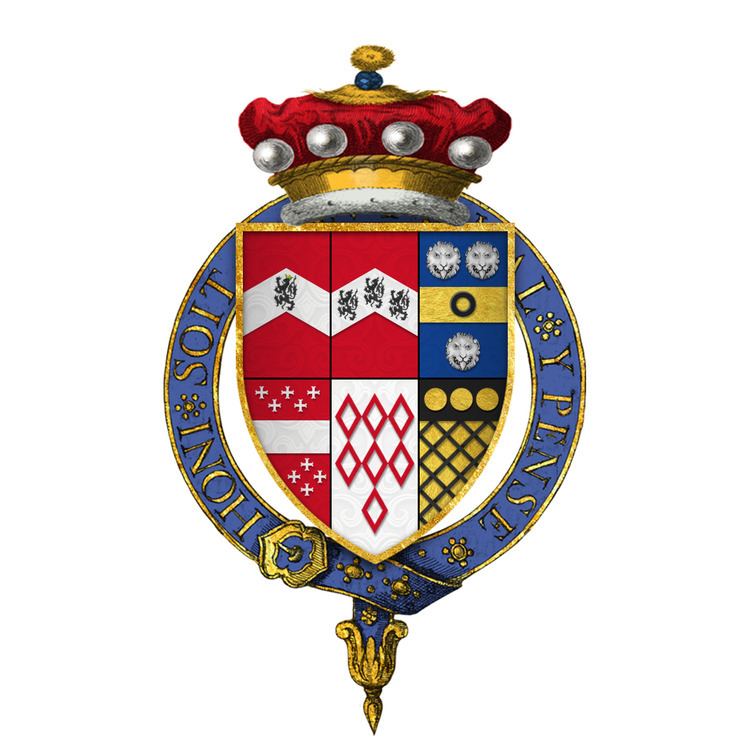Noble family Brooke | Name William 10th Died March 6, 1597 | |
 | ||
Spouse(s) Dorothy NevilleFrances Newton Children Maximilian Brooke, Sir William Brooke, Elizabeth Brooke, Frances Brooke, Margaret Brooke Parents Anne Brooke, Baroness Cobham, George Brooke, 9th Baron Cobham Cousins James Brooke, Thomas Wyatt the Younger Grandparents Edmund Braye, 1st Baron Braye, Dorothy Heydon, Thomas Brooke, 8th Baron Cobham | ||
Sir William Brooke, 10th Baron Cobham, KG (1 November 1527 – 6 March 1597) was Lord Warden of the Cinque Ports, and a Member of Parliament for Hythe. Although he was viewed by some as a religious radical during the Somerset protectorate, he entertained Elizabeth at Cobham Hall in 1559, signalling his acceptance of the moderate regime.
Contents
Biography
William Brooke was the son of George Brooke, 9th Baron Cobham (d. 29 September 1558), and Anne Braye (d. 1 November 1558).
Brooke's father died in 1558 when he was just over thirty. Brooke married Dorothy Neville, daughter of George Neville, 5th Baron Bergavenny in 1545, but the marriage was unhappy, and they separated after 1553. Brooke seems to have attended The King's School, Canterbury and Queens' College, Cambridge before 1544. He spent much of his younger life in Europe. In the early 1540s he visited Padua. At the end of the decade he served in northern France, where his father was in charge of Calais and in 1549 accompanied Paget's embassy to Brussels.
Like his father, Brooke sympathized with the anti-Marian nobles; he sided with the rebels during Wyatt's rebellion, and the intervention of his brother-in-law, Henry Nevill was needed to keep him from prison. In 1555 he served as MP for Rochester.
In the late 1550s, Brooke's opportunities expanded in a number of areas. His father died, making him Baron Cobham; his first wife died, leaving him free to marry Frances Newton (at Whitehall in 1560). He became Warden of the Cinque Ports, a position in which he wielded great power over a large number of seats in Parliament. Most important, the accession of Elizabeth, and his close friendship with William Cecil made him a powerful noble. Elizabeth deputed him to inform Philip II of Mary's death. This embassy was only the first in a long series of missions and intrigues. Along with Cecil, he numbered among his friends some nobles, such as Thomas Howard and the Earl of Arundel, whose loyalty to Elizabeth was far from certain. He suffered some months' house imprisonment as a result of a very tangential role in the Ridolfi plot. In 1578, he joined Francis Walsingham's failed mission to the Low Countries; on this mission he presumably served as Cecil's agent. In the late 1580s, he helped John Whitgift search for the author of the Martin Marprelate tracts.
Brooke was made a Knight of the Garter on 14 April 1585, and appointed to the Privy Council by 12 February 1586. He was involved in a minor capacity in the events that ended with the death of Mary, Queen of Scots. During the Armada crisis, he was on a diplomatic mission to Alexander Farnese, Duke of Parma. By the early 1590s he had assumed a less active role in government. His daughter married Robert Cecil in 1589. His second wife died in 1592. He succeeded Baron Hunsdon, as Lord Chamberlain in August 1596, and held the office until his death on 6 March 1597.
Marriages and issue
William Brooke married firstly Dorothy Neville (d. 22 September 1559), daughter of George Nevill, 5th Baron Bergavenny, by his third wife, Mary Stafford, daughter of Edward Stafford, 3rd Duke of Buckingham, by whom he had a daughter, Frances Brooke (b.1549), who married firstly Thomas Coppinger (1546–1580), and secondly Edward Becher (born c.1545).
He married secondly Frances Newton, by whom he had four sons and three daughters:
